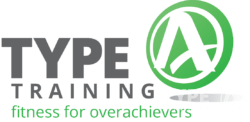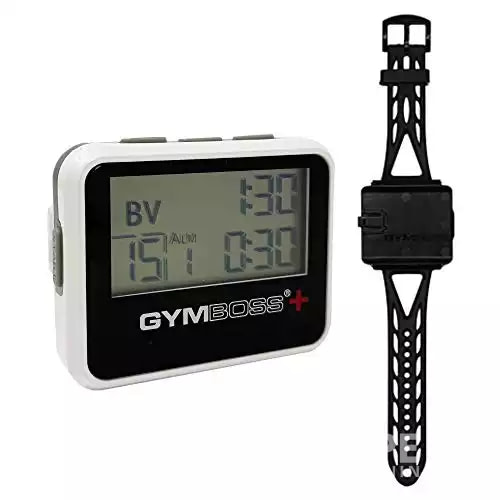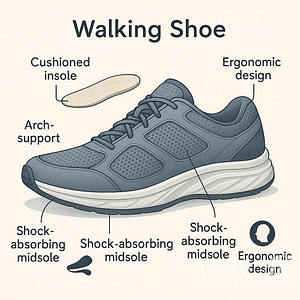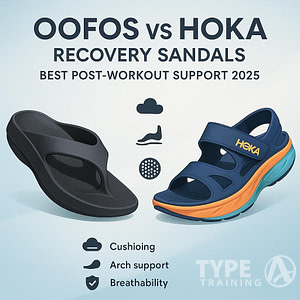EMOM workouts, or “every minute on the minute” workouts, are a game-changer for anyone looking to boost their fitness.
By performing a set number of reps at the start of every minute, you can challenge both your strength and endurance.
These workouts are highly effective because they keep you moving and help you make the most of your time.
Popular posts:
Whether you are new to fitness or an experienced athlete, EMOM workouts can be tailored to your level. They offer a great mix of cardio and muscle-building exercises, making them suitable for anyone.
This flexibility is one reason EMOM has gained popularity among fitness enthusiasts.
For those looking to track progress, EMOM workouts are easy to monitor.
You can adjust the reps or weight as you get stronger, ensuring you continue to make gains.
This makes EMOM a versatile and adaptable workout option for long-term fitness goals.
Key Takeaways
- EMOM workouts involve doing exercises at the start of each minute.
- They are suitable for all fitness levels due to their adaptable nature.
- Tracking progress with EMOM is straightforward and effective.
Understanding EMOM
EMOM (Every Minute on the Minute) workouts are a time-based exercise routine designed to build strength and endurance. These workouts are structured around performing a set number of reps for a given exercise at the start of every minute.
Principles of EMOM Workouts
EMOM workouts involve completing specific movements within a single minute.
If you finish early, the remaining time within that minute becomes your rest period.
This format keeps you moving at a consistent pace, balancing intensity and rest.
For example, if you are performing a set of 10 push-ups and 15 squats, you must complete these exercises within 60 seconds.
Any remaining time until the next minute is your recovery period before starting the next set.
Key principles:
- Consistency: Keeping a steady rhythm.
- Intensity: Pushing harder to finish faster.
- Rest: Rewarding effort with short breaks.
Benefits of EMOM Training
EMOM workouts offer multiple fitness advantages. The built-in rest periods ensure you maintain proper form while keeping the intensity high. This prevents overexertion and reduces injury risk.
By incorporating diverse movements, you can target different muscle groups and improve overall fitness.
Frequent rest intervals help maintain a vigorous pace throughout the session, improving cardiovascular health and muscular endurance.
Main benefits include:
- Efficiency: High-quality training in short periods.
- Variety: Flexibility to include various exercises.
- Adaptability: Suitable for all fitness levels.
EMOM workouts are ideal for those seeking efficient and effective training routines. They can be easily adjusted to fit personal goals and fitness abilities.
Key Components of EMOM
image credit: https://www.hungry4fitness.co.uk/post/full-body-emom-workouts
In an EMOM workout, timing is crucial, exercises are varied, and managed rest periods are as important as the workout itself. Understanding these components can help you effectively design and execute an EMOM routine.
Workout Structure and Timing
An EMOM workout stands for “Every Minute on the Minute.” This means you start a set of exercises at the beginning of every minute.
The number of sets and the overall duration could vary, but the consistent structure drives the workout.
You set a timer for a specific duration.
Within each minute, you perform the prescribed exercises, completing the reps as quickly as possible.
The remaining time in that minute is your rest period.
For instance, if an exercise set takes 40 seconds to complete, you rest for the remaining 20 seconds before starting the next set.
Exercise Selection
Choosing the right exercises for an EMOM workout ensures a balanced and effective routine.
Exercises are usually simple yet effective, such as push-ups, squats, and burpees. This repetitive nature allows you to focus on form and consistency.
It’s often beneficial to alternate between different exercises each minute.
For example, combining strength exercises with cardio moves can maintain intensity while preventing muscle fatigue. A sample could include 10 push-ups one minute, followed by 15 squats the next.
Rest and Recovery
Rest and recovery are key elements of an EMOM workout.
The time left in each minute after completing your exercises serves as your rest period.
Proper rest helps maintain intensity and effectiveness during the workout.
If exercises are too challenging, you might not have enough time to rest, leading to fatigue.
Adjust the reps or exercise difficulty to ensure you get adequate recovery.
Post-workout recovery techniques, such as stretching and hydration, are equally important to prevent injury and foster muscle growth.
Designing an EMOM Workout
Creating an effective EMOM workout involves setting clear fitness goals and picking the right exercises. By doing this, you can ensure your workout targets the muscle groups you want and maintains the correct intensity.
Setting Fitness Goals
Before starting, think about what you want to achieve with your workout.
Are you looking to build strength, improve endurance, or lose fat? Each goal needs a different approach.
For strength, choose exercises with heavier weights and lower reps. This focuses on pushing your muscles to their limit.
If endurance is your target, use lighter weights or bodyweight exercises with higher reps. This keeps your heart rate up and helps build stamina.
Knowing your goals will help you plan your workout better.
Set realistic and specific goals.
If you’re new to EMOM, start with shorter workouts and gradually increase the time and intensity.
Track your progress to see improvements and stay motivated.
Choosing the Right Exercises
Once you’ve set your goals, it’s time to choose exercises.
For an effective EMOM workout, select movements that target different muscle groups. This ensures a balanced workout and prevents overworking certain areas.
For strength, consider compound movements like squats, deadlifts, or bench presses.
These exercises work multiple muscle groups at once, giving you the most benefit in the shortest time.
For endurance, pick bodyweight exercises like burpees, push-ups, or jumping jacks.
These keep the intensity high and your heart rate elevated.
Try to mix up exercises to keep the workout interesting.
Pairing upper and lower body exercises can help maintain a balanced program. For example, you could alternate between squats and push-ups. This allows muscle recovery while keeping the workout intensity high.
EMOM Workouts for Beginners
EMOM (Every Minute on the Minute) workouts are great for beginners looking to build strength and endurance using simple, bodyweight exercises. These workouts are time-efficient and easily adaptable.
Getting Started with EMOM
To start with EMOM workouts, decide on a workout duration, typically 10-20 minutes.
Each minute, you will perform a specific exercise for a set number of repetitions, using any remaining time to rest.
Prepare by warming up with light cardio and dynamic stretching. This helps prevent injuries and gets your muscles ready for exercise.
Beginners should start with bodyweight movements, which are easier to perform and reduce the risk of injury.
Basic Exercises and Format
Choose exercises like squats, push-ups, and lunges. Here’s a simple format:
- Minute 1: Perform 10 push-ups.
- Minute 2: Do 15 air squats.
- Minute 3: Complete 12 lunges.
Continue alternating these exercises for the workout duration. If you finish early, use the remaining time to rest.
This setup keeps you moving and helps build a solid fitness foundation.
For a 12-minute beginner workout, you can repeat the sequence four times.
Adjust the reps based on your fitness level to ensure you can complete the exercises within the minute.
Stay consistent and gradually increase the intensity as you grow stronger.
Resources like EMOM Workouts for Beginners provide great examples and tips to help you get started.
Advanced EMOM Strategies
To take your EMOM (Every Minute on the Minute) workouts to the next level, you can increase both intensity and complexity, and incorporate various weights and equipment.
Increasing Intensity and Complexity
Push your limits by adding more challenging exercises. You might increase reps or reduce rest time.
Try complex movements like snatches, thrusters, or combined movements involving both upper and lower body.
For example, a sequence might include 10 kettlebell swings followed by 5 push-ups.
Vary your routine with exercises requiring different skills such as agility or coordination. Include a mix of strength training and cardio.
For instance, perform a series of deadlifts immediately after high-intensity burpees. This keeps your heart rate elevated while building muscle.
Incorporating Weights and Equipment
Introduce equipment like barbells, kettlebells, or resistance bands to add resistance to your workouts. This helps build muscle and strength more effectively.
For instance, a challenging set could be 3 reps of a barbell snatch every minute for 15 minutes.
Use various weights for different exercises.
Heavier weights are for exercises like deadlifts, while lighter weights can be for movements requiring more reps.
Incorporate gear like medicine balls for core workouts or TRX straps for bodyweight exercises.
This variety ensures comprehensive muscular development and keeps workouts engaging.
Common EMOM Variations
EMOM workouts (Every Minute on the Minute) can be tailored to different fitness goals by varying the exercises. Two common variations include bodyweight movements and using added weights like dumbbells or kettlebells.
Bodyweight EMOMs
Bodyweight EMOMs use exercises that require no equipment. These are effective for building endurance and muscle tone.
Popular exercises include push-ups, burpees, mountain climbers, and air squats.
For instance, you could do a 10-minute EMOM where you perform 10 push-ups at the start of each minute.
This type of workout is accessible and can be done anywhere, making it ideal for home workouts or when traveling.
To add variety and challenge different muscle groups, you can mix exercises.
An example might be doing 10 push-ups on the first minute and 15 mountain climbers on the second minute, and so on.
Weighted EMOMs
Weighted EMOMs incorporate equipment like dumbbells, kettlebells, or a barbell to increase resistance and build strength.
Common exercises include dumbbell thrusters, kettlebell swings, and barbell squats.
In a typical weighted EMOM, you might choose a compound movement like a dumbbell thruster.
For a 12-minute EMOM, perform 5 thrusters at the start of each minute.
The added weight makes these workouts more intense and targets muscle hypertrophy.
Another example is a 20-minute EMOM with 10 kettlebell swings each minute.
These workouts require more space and equipment but are highly effective for strength training.
Using weights in EMOMs ensures you get a full-body workout and can accommodate various fitness levels by adjusting the weight.
EMOM vs. Other Workout Formats
image credit: dailyburn.com
Different workout formats like AMRAP, Tabata, and CrossFit each offer unique ways to build strength, endurance, and improve cardiovascular health.
Each has its own set of rules and benefits, making it essential to understand their differences.
Comparison with AMRAP and Tabata
AMRAP (As Many Rounds As Possible):
While EMOM focuses on completing a set number of reps at the beginning of each minute, AMRAP challenges you to complete as many rounds of a series of exercises as possible in a given time frame.
This puts emphasis on both endurance and speed, pushing you to your limits.
Tabata:
Tabata workouts involve 20 seconds of high-intensity exercise followed by 10 seconds of rest, repeated for 4 minutes.
This form of HIIT (High-Intensity Interval Training) is different from EMOM’s structured timing and tasks.
Tabata’s short bursts aim to maximize calorie burn and improve cardiovascular fitness rapidly.
Key Differences:
- EMOM: Structured, specific repetitions, focus on maintaining form and completing tasks.
- AMRAP: Speed and endurance focus, aiming for maximum rounds.
- Tabata: High-intensity bursts, short rest periods, rapid improvement in cardio fitness.
Integrating EMOM into CrossFit
Strength Building:
Incorporating EMOM into CrossFit can help with strength building.
For example, you might lift a heavy weight at the start of every minute, allowing for both intensity and recovery.
This helps to manage fatigue and maintain a high level of performance.
Flexibility and Versatility:
EMOM workouts can easily be adapted to fit into various CrossFit routines.
Whether using bodyweight exercises or equipment, you can tailor the workout to target different muscle groups.
This makes EMOM a versatile tool in the CrossFit arsenal.
Endurance and Conditioning:
By structuring EMOM workouts to include a variety of movements like burpees, squats, or push-ups, you can work on both endurance and conditioning.
This ensures balanced improvements across multiple fitness areas, from strength to cardiovascular health.
Tracking Your Progress with EMOM
By using EMOM workouts, you can effectively track your fitness progress and set personal records.
It’s important to measure your improvement over time and focus on achieving new PRs to keep motivated.
Measuring Improvement Over Time
Tracking your progress with EMOM involves noting how quickly you complete your sets each minute and gradually increasing difficulty.
If you initially finish 10 push-ups in 50 seconds, your goal can be to reduce this time next session.
Using a workout journal helps.
Record the number of reps, the weight used, and how much rest you get each minute.
Over time, analyze these records to see improvements in your work capacity and muscular endurance.
When you notice you’re finishing sets faster and with less effort, it’s a clear sign of progress.
Setting and Achieving PRs
Setting and achieving personal records (PRs) in EMOM workouts means pushing your limits each session.
A PR may be doing more reps in the same time, lifting more weight, or completing sets quicker.
Aim to break your PRs regularly to build strength and endurance.
Adjust the variables such as reps, weight, or rest periods to challenge yourself.
For example, increase the weight for deadlifts or add more reps for push-ups.
Regularly review and reset your PR goals to maintain progress and stay motivated.
EMOM Workout Examples
EMOM workouts can be tailored to suit various fitness goals, whether you aim for fat burning, strength building, or endurance. Below, you’ll find specific examples and tips for customizing your workouts.
Sample Workouts for Different Goals
To burn fat, you can start with a high-intensity EMOM workout.
For instance, perform 20 jumping jacks at the start of every minute for 20 minutes. This keeps your heart rate high and maximizes calorie burn.
For strength, work on single-rep max lifts.
Using a squat or deadlift, do one rep with your three- or five-rep max every minute for 15 to 20 minutes. This helps in increasing muscle mass and strength.
If endurance is your goal, then try a varied routine.
Perform 15 wall ball shots in the first minute, 10 burpee broad jumps in the next, and so on.
Repeating this pattern for 30 minutes can improve both strength and cardiovascular fitness.
Customizing Workouts for Individual Needs
When customizing EMOM workouts, consider your current fitness level and any specific needs or limitations.
If you find certain exercises too difficult, substitute them with easier variations. For example, replace push-ups with knee push-ups if needed.
Adjust the rest periods to match your endurance.
If you’re new to fitness, allow more rest time between sets. For advanced athletes, minimize rest to increase intensity.
Tailor the equipment to what you have access to.
If you’re working out at home, use bodyweight exercises or light dumbbells. For gym workouts, incorporate equipment like barbells, kettlebells, and resistance bands.
Divide your workouts into sets that align with your fitness goals, ensuring you challenge yourself while avoiding strain or injury.
Essential Equipment for Tabata Workouts
Not much equipment is needed for a Tabata workout, but having the right tools can significantly enhance your routine. Here are some basic items to consider:
- Tabata Timer: A dedicated Tabata timer helps you keep track of the 20-second work and 10-second rest intervals, ensuring you stay on pace.
- Smart Watch: A smartwatch can monitor your heart rate, track calories burned, and provide interval timing to keep you on schedule.
- HIIT Timer Apps: Numerous apps are available that offer customizable interval timers specifically designed for HIIT and Tabata workouts.
Tabata Timers
|
3.5
|
3.5
|
3.5
|
3.5
|
|
N/A
|
N/A
|
$29.95
|
$26.95
|
Smart Watches
|
3.5
|
3.5
|
3.5
|
3.5
|
|
N/A
|
$309.00
|
$299.99
|
$302.00
|
5 Best HIIT Timer Apps
1. Interval Timer – HIIT Timer:

2. Seconds Interval Timer:
3. Tabata Pro:
4. Tabata Timer for HIIT
5. Tabata Stopwatch Pro:
Frequently Asked Questions
EMOM workouts offer flexibility for various fitness levels and can be seamlessly combined with CrossFit training. These workouts are easy to perform at home using bodyweight exercises or equipment like kettlebells.
What are the benefits of EMOM workouts at home?
EMOM workouts can be very effective for improving your fitness at home.
They allow you to manage your time efficiently and don’t require much space or equipment. This makes them ideal for keeping fit without needing to go to the gym.
How do EMOM workouts integrate with CrossFit training?
EMOM workouts fit well with CrossFit because both emphasize short, intense bursts of activity.
Adding EMOM routines to your CrossFit training can improve your endurance and strength. They also help to structure your workout and keep you moving consistently.
Can you give examples of EMOM workouts for different fitness levels?
For beginners, you might start with 10 squats and 5 push-ups every minute for 10 minutes.
Intermediate workouts could include 15 kettlebell swings and 10 burpees.
Advanced participants might try 5 back squats at 75% of their max lift followed by pull-ups using a challenging weight.
What makes a well-structured EMOM workout plan?
A well-structured EMOM workout includes a balance of movements targeting different muscle groups.
It should start with a warm-up and include exercises that match your fitness goals.
Setting realistic and challenging targets for each minute is key to maximizing benefits.
How can bodyweight movements be incorporated into EMOM workouts?
Bodyweight movements like push-ups, squats, and burpees are excellent for EMOM workouts.
You can perform these exercises anywhere, making them perfect for a home workout. Combining them efficiently helps to develop strength and improve your cardiovascular health.
What are some effective EMOM workouts using kettlebells?
Kettlebells add variety and resistance to your EMOM workouts.
For example, you can perform 15 kettlebell swings and 10 goblet squats every minute for 10 minutes.
You might also try alternating 20 kettlebell snatches with 10 kettlebell cleans to keep the workout challenging and engaging.













![Apple Watch Series 9 [GPS 41mm] Smartwatch Fitness Tracker, Blood Oxygen & ECG Apps](https://mlrsaszawtm3.i.optimole.com/cb:4PHY.45cbb/w:auto/h:auto/q:90/f:best/ig:avif/https://www.typeatraining.com/wp-content/uploads/2023/10/31xWycYXNmL._SL500_.webp)












